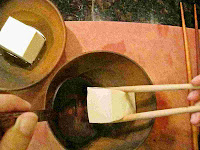<Ingredients>
700-1000 cc dashi (enough to almost cover tofu in a small pot)
For topping
Handful shiso perilla leaves and flowers
1 tbsp chirimen jako young dried sardines
1 tsp sake
1 tsp mirin
1 tsp usukuchi soy sauce
1/2 tsp sesame oil (not in photo)
<Directions>
1.
Remove shiso flowers from stems (save a few stems with flowers for garnish).
Cut shiso leaves lengthwise, and thinly slice crosswise.
2.
In a small pot, put some dashi and tofu. Add dashi as necessary to where it almost covers tofu.
Heat on medium to medium high, and reduce heat to medium low or low when dashi almost boils.
3.
In the meantime, put chirimen jako in a small frying pan, and saute without oil on medium low heat until somewhat crispy.
Add sesame oil, and stir.
4.
Once chirimen jako are coated with oil and become toasty, add shiso leaves and flowers, and saute.
When shiso leaves are done, add sake, mirin and soy sauce, and continue cooking while occasionally stirring, until liquid is almost gone.
5.
Place warm tofu on individual plates or in bowls, and top with shiso-chirimen jako mixture.
Garnish with fresh shiso flowers.
<Notes>
- The green-leaf shiso plant called aojiso has white flowers. Pink flowers are from akajiso (purple-leaf perilla plant); shiso plants with leaves that are green on top and purple underneath also have pink flowers (photo at right).
- Hanaho means perilla flowers. (Flower spikes are called hojiso.)
- The fresh flowers for garnish can also be eaten together with tofu. They have a soft, refreshing taste (milder than fresh shiso leaves).
- Alternatively, set aside 1/4-1/3 of flowers, and mix in cooked flowers, leaves and chirimen jako before serving with tofu. That way, the flower color is noticeable. If you do this, the topping tastes milder and airier than otherwise.
- First sauteing chirimen jako without oil eliminates the fishy taste.
- Shirasu can substitute for chirimen jako.
- If dashi is not available, put a piece of kombu kelp in water. If kombu kelp is not available, water by itself can be used. The dashi used to heat up tofu can be used for other dishes.
- For both hiyayakko (cold tofu with topping) and nukuyakko or nuruyakko (warm tofu with topping), soft tofu is normally selected.
- The topping can be prepared in advance.


(Last updated: March 7, 2015)
















No comments:
Post a Comment